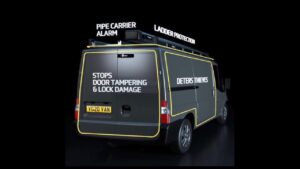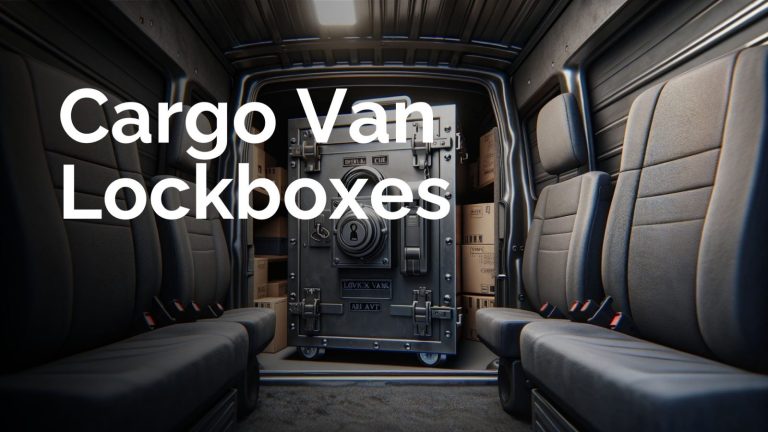

Gaining an understanding of cargo van lockboxes is pivotal in comprehending the importance of vehicle security, particularly for cargo van owners. This section will delineate what cargo van lockboxes are and why they are significant.
Cargo van lockboxes are secure storage units that are installed in cargo vans. They are typically made of heavy-duty steel and are designed to be tamper-proof and resistant to cutting, drilling, and prying. These lockboxes provide an extra layer of security for shipping containers, ensuring the contents are safe from unauthorised access and theft.
The installation process of cargo van lockboxes is relatively straightforward and can be done by following the manufacturer’s instructions. These lockboxes are strategically placed within the cargo van to maximise security and prevent shifting during transit.
The usage of cargo van lockboxes is a crucial security measure, especially when transporting high-value cargo or sensitive items that require an extra level of protection. They provide added security for valuable items and tools stored in a vehicle, protecting them from theft and damage (Safety Skills).
In addition to providing enhanced security, cargo van lockboxes can help businesses comply with industry regulations and insurance requirements for securing valuable items and tools during transportation.
Many shipping companies now offer containers with lockboxes as a standard feature, ensuring that cargo remains secure during transit. This enhanced security measure demonstrates their commitment to providing safe and secure transportation of goods.
In conclusion, the implementation of cargo van lockboxes is a significant step towards safeguarding valuable goods during transportation. They provide a robust and reliable solution to enhance the security of cargo vans. At the same time, they help businesses meet industry standards and insurance requirements, making them an essential component of cargo van security.
Understanding the materials used in the construction of lockboxes and their design features is crucial for cargo van fleet owners. It enables them to make informed decisions when selecting the best cargo van lockboxes to safeguard their goods.
Cargo van lockboxes are typically made of heavy-duty, durable materials such as steel. The use of steel in their construction makes them robust and resistant to tampering or break-ins. Steel, being a hardy material, is resistant to cutting, drilling, and prying, providing an additional layer of security to your cargo.
The durability of steel means the lockboxes can withstand harsh conditions and still maintain their structural integrity, safeguarding the valuable goods inside them. This makes them an ideal choice for fleet owners seeking long-term security solutions for their cargo vans.
The design of cargo van lockboxes is another critical aspect to consider. They are fashioned to be tamper-proof, increasing their effectiveness in preventing theft.
One key design feature of cargo van lockboxes is the advanced locking mechanisms. These mechanisms are designed to prevent unauthorised access, enhancing the security of the goods stored in the cargo van.
Lockboxes also come in different sizes and shapes, allowing for customisation based on the specific needs of the cargo van. This flexibility in design ensures that they can accommodate different types of goods, regardless of their size and shape.
In conclusion, the material and design features of cargo van lockboxes contribute significantly to their effectiveness in safeguarding goods in cargo vans. Fleet owners should carefully consider these factors when selecting lockboxes to ensure they choose the best cargo van lockboxes for their security needs.
Installing cargo van lockboxes is a crucial step in improving the security of your fleet. This section will guide you through the process, providing a step-by-step approach as well as tips on customising your installation.
The installation process for cargo van lockboxes is relatively straightforward, and can usually be accomplished by following the manufacturer’s instructions Safety Skills. Lockboxes can be installed on both new and used shipping containers, providing added security without the need for extensive modifications Container xChange.
Here is a general overview of the steps involved:
While the general installation process is suitable for most lockboxes, there may be cases where you need to customise the installation to better suit your needs. For instance, one van owner purchased a Buyers Products 1703349 Toolbox on Amazon and modified it to fit under their bench seat Texas Vanagons. They used Apexstone Gas Struts to keep the lock box door propped open Texas Vanagons.
Depending on the specific needs of your cargo van fleet, you might need to make similar modifications. Always ensure that any customisation does not compromise the functionality of the lockbox or the safety of the vehicle.
In summary, installing cargo van lockboxes is a practical step that can significantly enhance the security of your fleet. By following the manufacturer’s instructions and making necessary customisations, you can ensure that your lockboxes provide the best possible protection for your goods.
Cargo van lockboxes offer significant benefits, particularly in terms of security and compliance with regulations. They are an important addition to any cargo van, especially those used for transporting valuable items or equipment.
A primary advantage of cargo van lockboxes is the additional security they provide. Lockboxes are typically made of heavy-duty steel and are designed to be tamper-proof, making it difficult for thieves to break into the container (Container xChange). This feature presents a formidable deterrent to would-be thieves.
Many shipping companies now offer containers with lockboxes as a standard feature, ensuring that cargo remains secure during transit. This is particularly crucial for high-value cargo or sensitive items that require an extra level of protection (Container xChange).
Also, cargo van lockboxes provide added security for valuable items and tools stored in a vehicle, protecting them from theft and damage. Installing a cargo van lockbox can help deter theft and reduce the risk of insurance claims for stolen or damaged tools and equipment (Business Fleet).
Using cargo van lockboxes can also help businesses comply with industry regulations and insurance requirements for securing valuable items and tools during transportation.
The Federal Motor Carrier Safety Administration (FMCSA) has specific regulations regarding the securement of cargo. These regulations, published on September 27, 2002, are designed to prevent shifting or falling of articles from commercial motor vehicles. Motor carriers operating in interstate commerce must comply with these rules starting from January 1, 2004 (FMCSA).
By implementing cargo van lockboxes, businesses can demonstrate their commitment to adhering to these regulations. This not only ensures the safety of their cargo but also their credibility and reputation in the industry. So, from both a security and compliance perspective, the implementation of cargo van lockboxes presents a smart investment for any cargo van fleet owner.
Real-world examples provide valuable insights into the practical application and benefits of cargo van lockboxes. Let’s look at two case studies: a DIY cargo van lockbox and a professional cargo van lockbox designed for camera equipment.
In a DIY project documented by ITS Tactical, the author created a lockbox for their Jeep Wrangler to secure and organize essential supplies. Given the soft top of the Jeep, the vehicle was easily accessible, necessitating a lockable storage solution. The lockbox, designed to fit behind the backseat, opened via the tailgate.
The author initially crafted a small lockbox from particle board. However, with the need to accommodate a larger quantity of items, including medical kits, fire starting tools, recovery gear, tools, sleeping bag, extra food, water, clothing, and bulkier items, they decided to build a bigger lockbox.
Constructed using MDF for its strength and durability, the lockbox was secured using toggle bolts. The author plans on replacing these with longer hex bolts in the future. To fit the lockbox to the shape of the Jeep’s tub, the front and support sections were assembled using screws, with a countersink set recommended for woodworking.
A professional photographer, as reported by Texas Vanagons, sought to secure their camera equipment and laptop while away from their van. They purchased a Buyers Products 1703349 Toolbox on Amazon and modified it to fit under their bench seat.
The lockbox features a large locking handle that is keyed and was intended to be mounted with the door opening vertically, but the author modified it to be a top-loading box. Apexstone Gas Struts were used to keep the lockbox door propped open.
These case studies demonstrate the flexibility and practicality of cargo van lockboxes, whether DIY or professionally crafted. They highlight the peace of mind these lockboxes can provide, knowing that valuable equipment and essential supplies are securely stored while on the move.
When considering the installation of cargo van lockboxes, it’s essential to understand the regulatory landscape and how these security solutions fit within it.
The Federal Motor Carrier Safety Administration (FMCSA) published new cargo securement rules on September 27, 2002. Motor carriers operating in interstate commerce have been required to comply with these rules starting from January 1, 2004. Derived from the North American Cargo Securement Standard Model Regulations, these rules aim to prevent articles from shifting or falling from commercial motor vehicles, with the goal of reducing accidents caused by cargo mishaps.
The rules apply to all cargo-carrying commercial motor vehicles operated in interstate commerce, covering all types of articles of cargo except commodities in bulk without structure or fixed shape.
Furthermore, the FMCSA has adopted new performance requirements for cargo securement systems, which include deceleration in the forward direction and acceleration in the rearward and lateral directions. The systems must be capable of withstanding these forces.
Cargo van lockboxes can play a significant role in helping motor carriers meet these regulatory requirements. By providing a secure, fixed space for cargo, lockboxes help prevent cargo from shifting or falling during transit – a key goal of the FMCSA regulations.
Motor carriers are not required to conduct testing of cargo securement systems to determine compliance with the performance requirements. Cargo immobilised or secured in accordance with the general securement rules or the commodity-specific rules is considered to meet the performance criteria (FMCSA).
Furthermore, all devices and systems used to secure cargo, including lockboxes, must be capable of meeting the performance criteria. Vehicle structures, systems, parts, and components used for cargo securement must be in proper working order with no damaged or weakened components that could affect their performance (FMCSA).
In summary, cargo van lockboxes can play a vital role in helping motor carriers comply with FMCSA cargo securement regulations. By providing a secure, fixed space for cargo, these lockboxes contribute to safer, more secure transit for all types of cargo.

Michael Horsfall, a seasoned plumbing and heating engineer with over 35 years of trade experience, is the innovative mind behind VanGuardian, a proactive van security solution. His journey into the realm of security was triggered by recurrent incidents of theft, particularly copper pipe theft right from outside his residence in Leeds. The rampant van crimes led him to envision VanGuardian, a patented alarm system engineered to deter theft by activating upon contact, safeguarding assets before any damage occurs. Michael's in-depth understanding of the challenges faced by tradesmen, paired with his endeavor on Dragons' Den to secure investment, underscores his commitment to fostering van safety. His profound expertise and real-world experience equip him with a distinctive insight, making his blogs an invaluable resource for individuals seeking pragmatic advice on van safety and security.

Copyright © 2021 VANGUARDIAN
VANGUARDIAN is a registered trademark of PROTEK-ONE, company no. 11802780.
